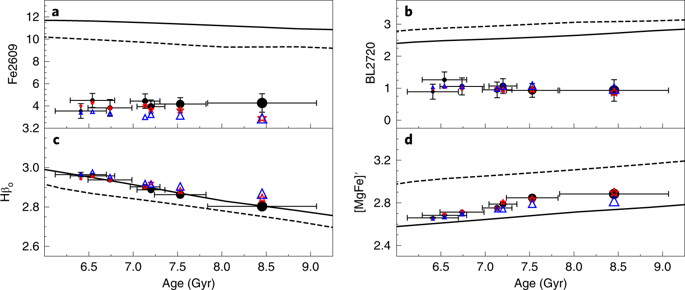Nature Astronomy ( IF 14.1 ) Pub Date : 2019-12-16 , DOI: 10.1038/s41550-019-0955-0 Núria Salvador-Rusiñol , Alexandre Vazdekis , Francesco La Barbera , Michael A. Beasley , Ignacio Ferreras , Andrea Negri , Claudio Dalla Vecchia

|
Early-type galaxies are considered to be the end products of massive galaxy formation1. Optical spectroscopic studies reveal that massive early-type galaxies formed the bulk of their stars over short timescales (\(\lesssim\)1 Gyr) and at high redshift (z \(\gtrsim\) 2), followed by passive evolution to the present2. However, their optical spectra are unable to constrain small episodes of recent star formation, since they are dominated by old stars. Fortunately, this problem can be tackled in the ultraviolet range. While recent studies that make use of ultraviolet absorption lines have suggested the presence of young stars in a few early-type galaxies3, the age and mass fractions of young stars and their dependence on galaxy mass are unknown. Here we report a detailed study of these young stellar populations, from high-quality stacked spectra of 28,663 galaxies from the BOSS survey4, analysing optical and ultraviolet absorption lines simultaneously. We find that residual star formation is ubiquitous in massive early-type galaxies, measuring average mass fractions of 0.5% in young stars in the last 2 Gyr of their evolution. This fraction shows a decreasing trend with galaxy stellar mass, consistent with a downsizing scenario5. We also find that synthetic galaxies from state-of-the-art cosmological numerical simulations6 substantially overproduce both intermediate and young stellar populations. Therefore, our results pose stringent constraints on numerical simulations of galaxy formation6,7.
中文翻译:

在红色大质量星系中,年轻恒星的质量分数低于百分之一
早期类型的星系被认为是大规模星系形成的最终产物1。光谱学研究表明,大量的早期类型星系在短时间尺度(\(\ lesssim \) 1 Gyr)和高红移(z \(\ gtrsim \) 2)上形成了大部分恒星,随后被动演化为恒星。目前2。但是,由于它们的光谱受旧恒星的支配,因此它们的光谱无法限制最近形成的恒星的小事件。幸运的是,可以在紫外线范围内解决此问题。尽管最近利用紫外线吸收线进行的研究表明,一些早期类型的星系中存在年轻恒星3,年轻恒星的年龄和质量分数及其对星系质量的依赖性尚不清楚。在这里,我们从BOSS调查4的28,663个星系的高质量叠加光谱中报告了这些年轻恒星种群的详细研究,同时分析了光和紫外线吸收线。我们发现残留的恒星形成在大规模早期星系中无处不在,在其演化的最后2个Gyr中,年轻恒星的平均质量分数为0.5%。这部分显示出随着星系恒星质量的减少趋势,这与缩小场景5一致。我们还从最新的宇宙学数值模拟中发现合成星系6大量生产中级和年轻的恒星种群。因此,我们的结果对星系形成6,7的数值模拟提出了严格的约束。



























 京公网安备 11010802027423号
京公网安备 11010802027423号